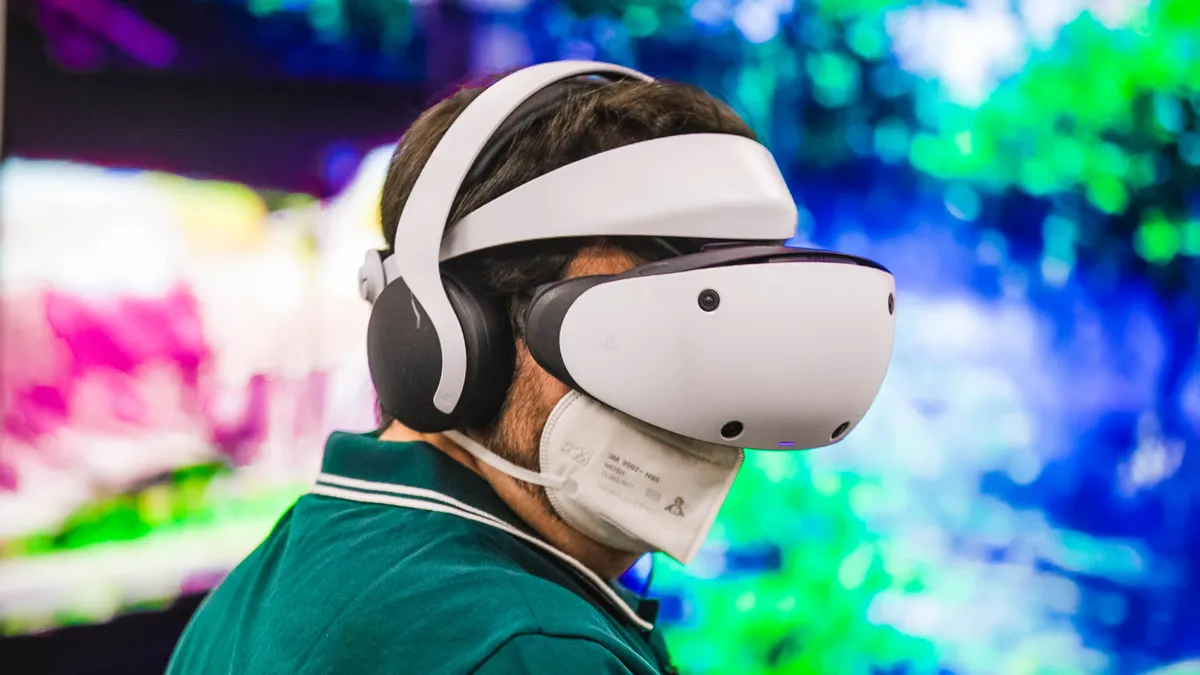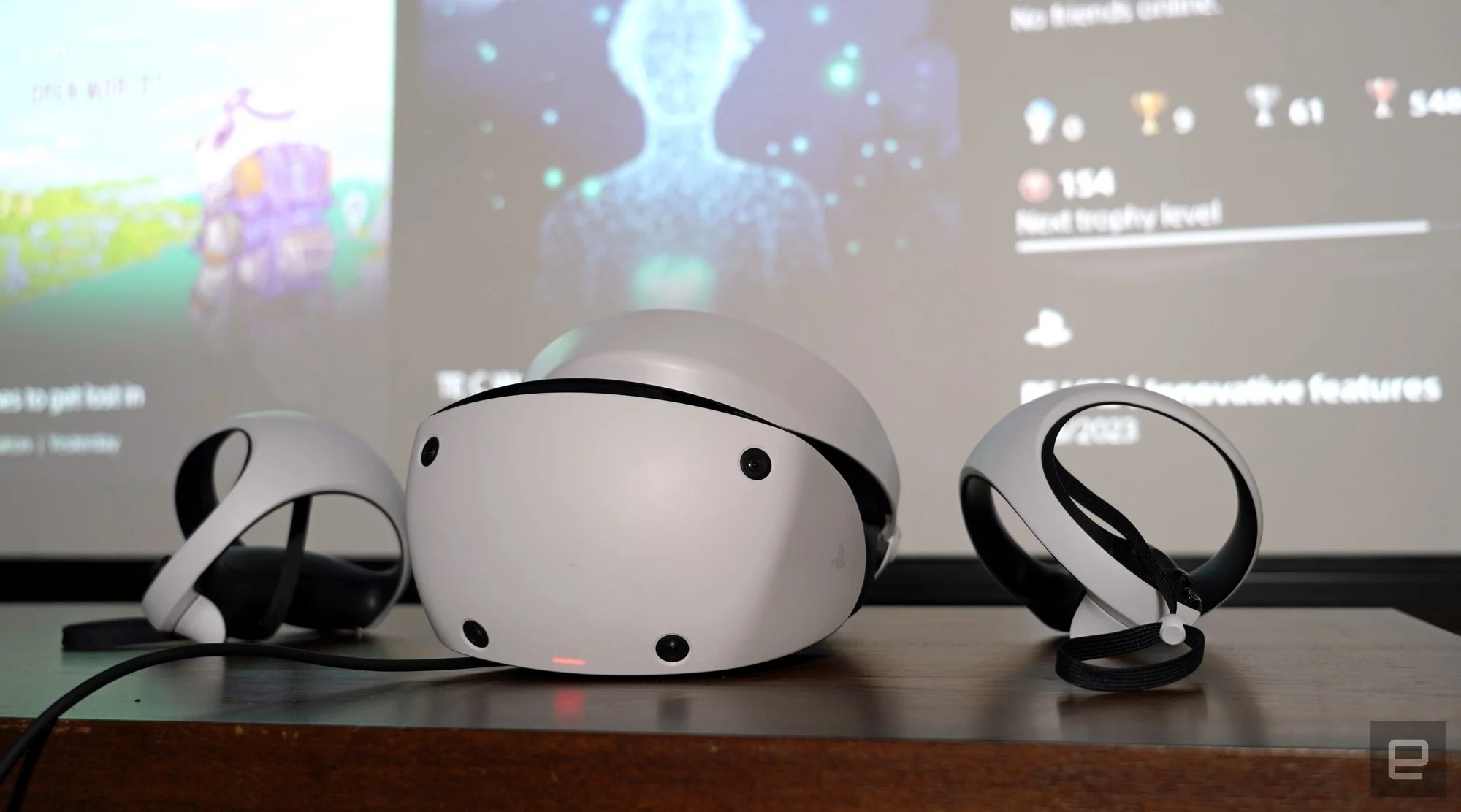A Comprehensive Review of the PlayStation VR 2
The PlayStation VR 2 headset is not just an upgraded version of the original virtual reality headset. The PS VR 2 revolutionizes console VR by taking a lot from the previous generation and fixing some of the problems that the first generation had.
The PlayStation VR 2 is very similar in design to the PS VR 1 but has a white color scheme to match the PS5 console. It works by using a similar headband that secures the headset to your head. Then, the VR goggle portion slides back to lock it in place in front of your eyes. As it does not put pressure on the eyes like the PS VR 1, this headset is much more comfortable than the others. Additionally, the sliding mechanism makes wearing glasses easier while using the PS VR 2.
The PlayStation VR 2 headset can be put on in a few steps. First, adjust the back portion of your headband to fit your head. To secure the headband in place, the user twists a knob at its back. The visor’s visor can be adjusted by pressing a button at the back of the band. It is easy to take off the headset using the knob at the headband.
The PS VR 2 feels comfortable, but it is not restrictive. The PS VR 2 doesn’t move around or slip, and the material surrounding the lenses blocks out outside light and distractions. The headset is lightweight and not too bulky, which means that users can engage in longer VR gaming sessions.
The PlayStation VR 2’s familiar interface is what makes it so much more enjoyable. This headset uses an inside-out tracking VR headset. It does not require trackers or cameras for determining the user’s movements or that of the controller. Instead, the headset’s front end has four cameras that register head movements and help you adjust the picture in-game.
Inside-out tracking eliminates many of the restrictions when it comes to playing in a certain area. The user doesn’t have to stand in front of the TV or mount the camera. They can simply find the area that allows them to move the most. VR games that support sitting gameplay don’t require users to be in a specific position. They tell/show the headset where to place the headset to create the play space.
Two 4K OLED displays are housed inside the PS VR 2 headset. They support up 120Hz. This headset offers immersive virtual reality, and the displays provide a remarkable level of clarity. Displays of the headset are awe-inspiring as long the design allows it.

Software and hardware options can be added to enhance the immersion and make it more personal. The eye-tracking software allows the headsets to focus on what the user is seeing. It is astonishingly effective. The headset’s wide angle allows the user to see beyond the display’s borders, so it’s not like looking through binoculars. A lens adjustment wheel is located on the top of the headset to match the spacing between users’ eyes.
The PS VR 2 headset has a solid tech foundation that can deliver stunning visuals. Virtual reality users will often need to make adjustments to get the best experience from their headsets. Sony has equipped the PS VR 2 with enough adjusters that it can be used by anyone regardless of their head shape, eye spacing, or whether they wear glasses.
To add a sense of immersion, the headset has tactile feedback. This is subtle and effective but still very effective (where available). The headset would emit a slight pulse when something passes by the headset or interacts with the player’s character in-game.
For true virtual reality immersion, visuals only are part of the equation. Sound is just as important to that sense of place and space. The PS VR 2 headset ships with a unique earbud system that plugs into the headset’s headset’s headband, secure it in place and is removable. The earbuds can be attached to each ear by pulling down from the left or right sides of the headset’s headband. While the PS VR 2 offers three sizes of earbud cups, these are not perfect and may not fit perfectly. The system is simple to use for accessing the earbuds and then unplugging them.
Tempest 3D tech from the PS VR 2 is responsible for the excellent audio quality of the earbuds. The headset tracks the head position and sends audio in the right direction. While it may not be the most advanced audio experience, it is very good and can complement the headset’s visuals.
Two other, small but important parts of the PS VR 2 can be found on the undersides of the VR goggles. They are the microphone (and the pass-through) and the button. We didn’t use the microphone much during our review but Call of the Mountain used it to give the impression that we were blowing on objects, such as pan flutes in-game. The pass-through buttons are a great boon because they use the headset’s cameras and show exactly what is in front. Although VR games can seem disorienting after a while, the pass-through button allows you to quickly pause them and show where you are in the room.

PSVR 2 Controllers are a huge leap forward
Sony has also completely redesigned the PS VR 2’s control system, swapping out the Move controllers for a set that looks more like the Oculus Quest controllers. Cool features include round hoops on their bottoms that appear to prevent the hands from hitting anything while playing.
In terms of function, the PS VR 2 controllers look like two flight sticks. Each has a joystick with two buttons and a set of two face buttons. They each have an adaptive trigger to mimic the tension of performing actions and a larger button (L1-R1) in the grip.
They work great, regardless of whether the game is motion-heavy or traditional joystick motion control. Except for one incident in which the headset lost track of the left controller, and required a restart, the headset performed very well to identify where they were in relative space. Additionally, the controllers allow for more realistic interactions such as gripping a ledge or firing off a gun.
The PSVR2 controllers perform well in comparison to other virtual reality controllers. Although it was not used in Horizon much, the controllers are equipped with finger touch detection, which allows your avatar to do things such as point, make peace signs, and even ball up their fists. It makes it feel that the user is doing more than waving static hands in the air.
You can set up EasySetup 2
It is very easy to set up the PS VR 2 and use it. The software will take you through several steps to help you adjust your lens spacing or fine-tune your eye tracking. It uses the camera to determine how much space is available for the user to play virtual reality games. It locates any obstacles such as walls, couches, tables, or other obstructions and creates a play space for the user. You can also adjust the play space if it is inaccurate, but we found it to be very accurate in our testing.
The PS VR 2 is very demanding for room-scale experiences. It requires 6′ 7″, X6′ 7″, of space. Those with smaller rooms, can create as much space as possible while still enjoying a great VR experience. You can switch easily from standing VR to room-scale VR by pressing the options button. Even if you’re in the same space, the headset can remember what play area it created.
While the VR headset’s wire can sometimes be in the way of the headset’s movement, it’s not nearly as heavy as the bulkier 1.0 headset. The PS VR 2 did not have any issues recognizing our controllers or our movements, no matter how large or small the room was. VR’s inability to “fit” within a space is one of its biggest problems. But the PS VR 2 allows for all kinds of adjustments and options that can make VR work anywhere.
VR Game Testing with PS5
Horizon, the highlight of PS VR 2, is undoubtedly Call of the Mountain. It makes the most of every feature the headset has to provide. It is an amazing VR experience that adapts the main title’s combat and traversal to a more limited setting. Combat is where the game differs most from its predecessors. It confines the player to a circular arena where they can dodge around the robot-animal, and fire arrows when it’s weakest.
The Horizon: Call of the Mountain climbing experience is however a good representation of the real deal. Players will use different handholds to “pull themselves up cliffsides or ropes or across vines. This is a very simple gameplay mechanic, but it is so well executed from both a visual and motion control perspective that it’s hard not to feel immersed. Climbing can also be quite a workout.
Horizon Call of the Mountain will show you everything the headset can do. However, it’s far from the only excellent game available for the PlayStation VR 2. Many VR titles have been transferred to PS VR 2 to make use of many of the system’s most important components. The majority of the games don’t support room scales or finger tracking. However, it is important to note that the porting process doesn’t affect any functionality. All the games feel like they are a lesser version of Quest/Vive/Index; the gameplay is as rich and complex as any other.
The pre-release reviews included Horizon: Call of the Mountain; Kayak Mirage, VR, Tentacular; After the Fall; Moss Books 1 & 2, What the Bat; Star Wars: Tales from the Galaxy’s Edge and Jurassic World Aftermath. All of them offer a different VR experience and work well on the PS VR 2; they are worth checking out.
While it is likely that developers will not be able to use the PS VR 2 as fully as Call of the Mountain, eventually features such as finger touch and eye tracking will become part of the experience. The unique features of PS VR 2 will be important to developers, just as Sony placed a lot of emphasis on Dual Sense’s feature set during the PS5 launch.
Virtual reality is seen by many gamers as a gimmick and a fad. It is also expensive and may not be suitable for everyone. If you do decide to get into the PlayStation VR ecosystem, whether for the first or second time, you’ll find a great headset/controller combo. A wide selection of titles highlights the best of VR. In Horizon Call of the Mountain’s case, the entire potential of the PlayStation VR platform.
Sony will face two major obstacles in selling PS VR 2: price and interest. But, the PS VR 2 has made incredible strides. Sony’s headset can compete with the best thanks to its simple setup, clever controls, and thoughtful ease of use.
PlayStation VR 2 will be released on February 22, 2023. Game Rant was given a prerelease retail unit to facilitate this review.